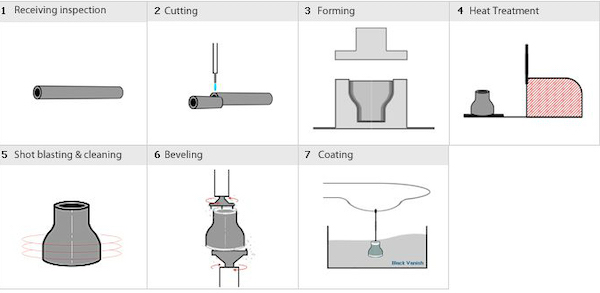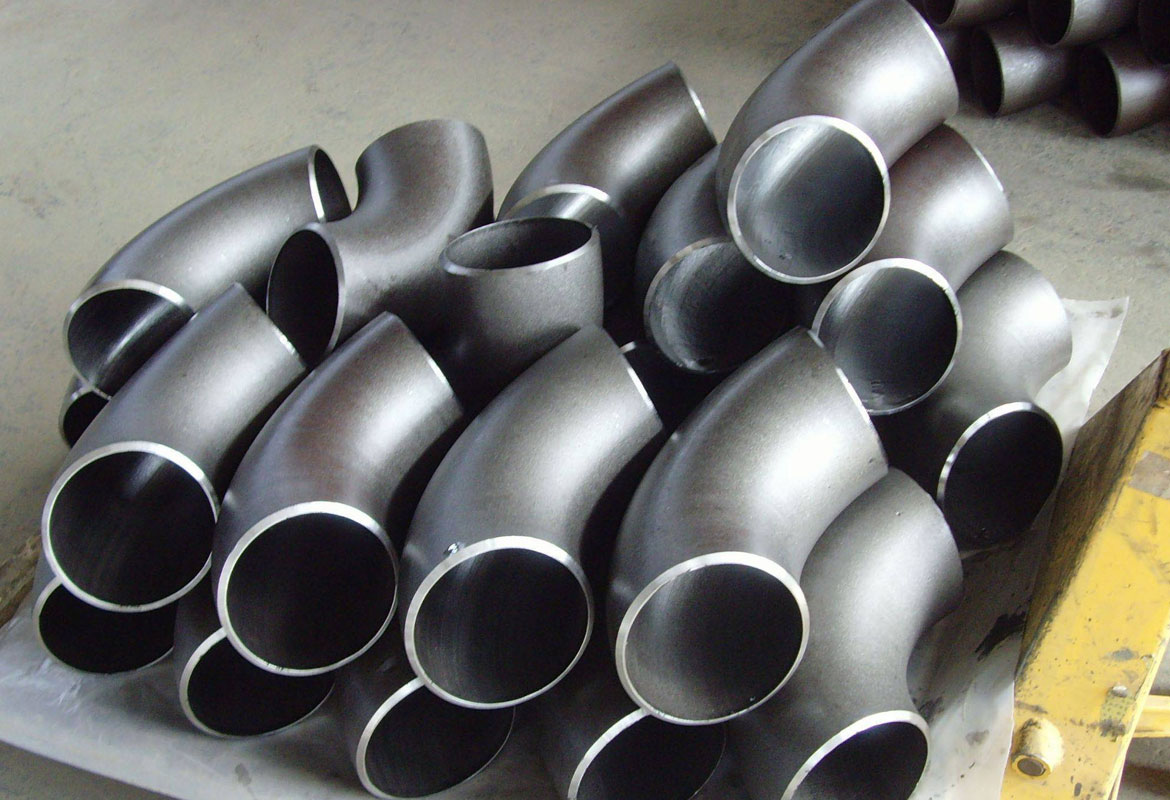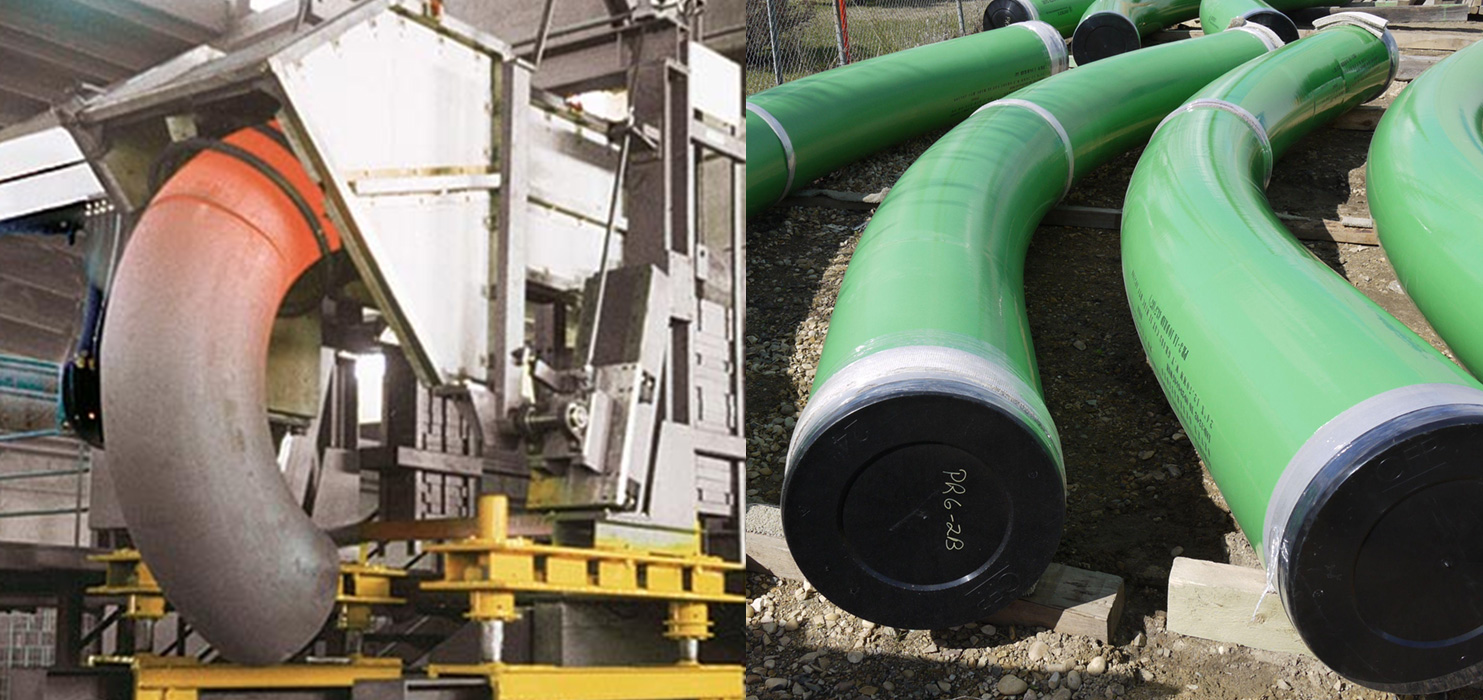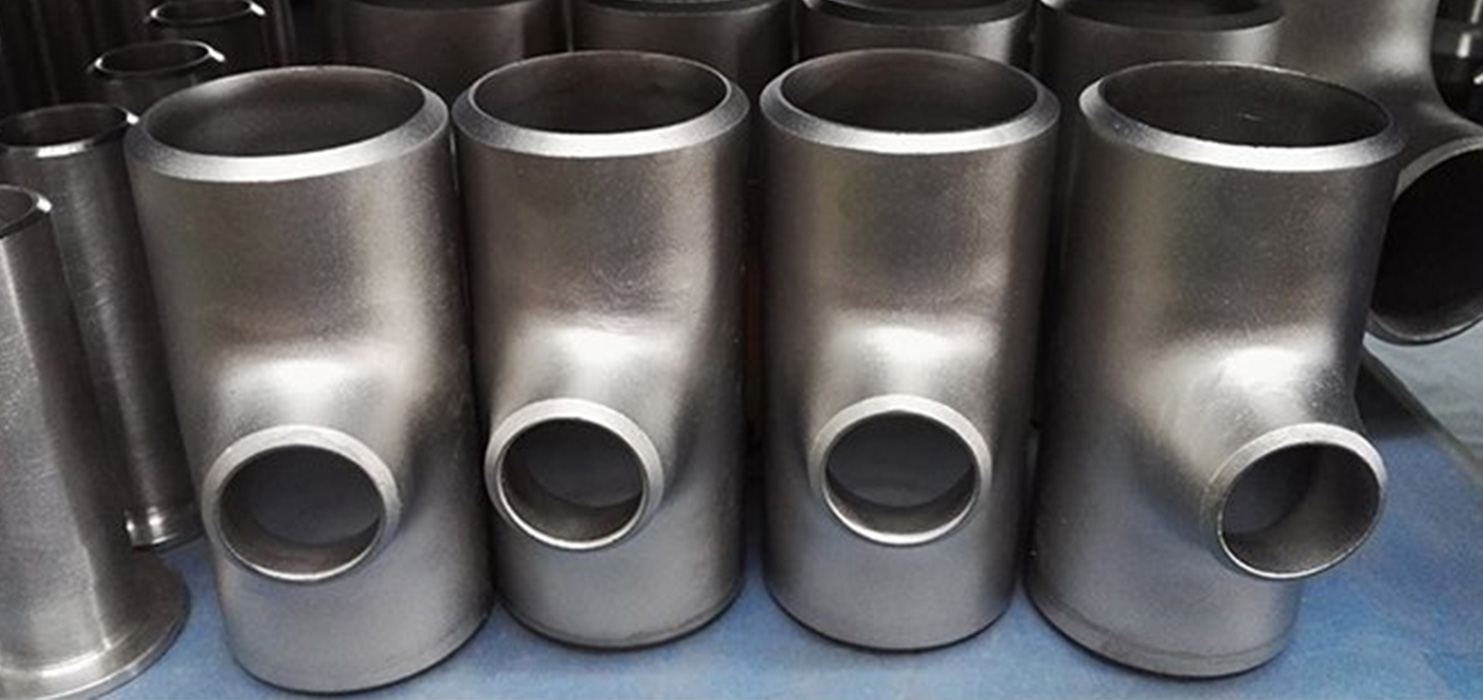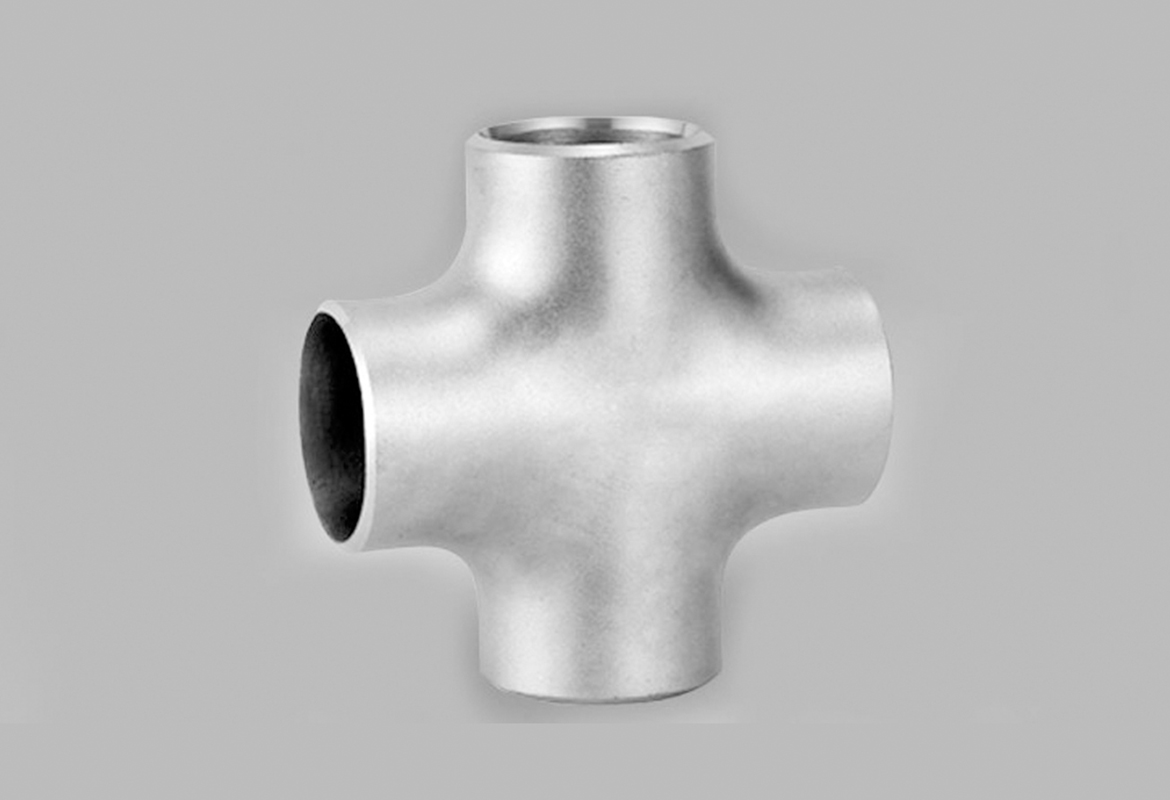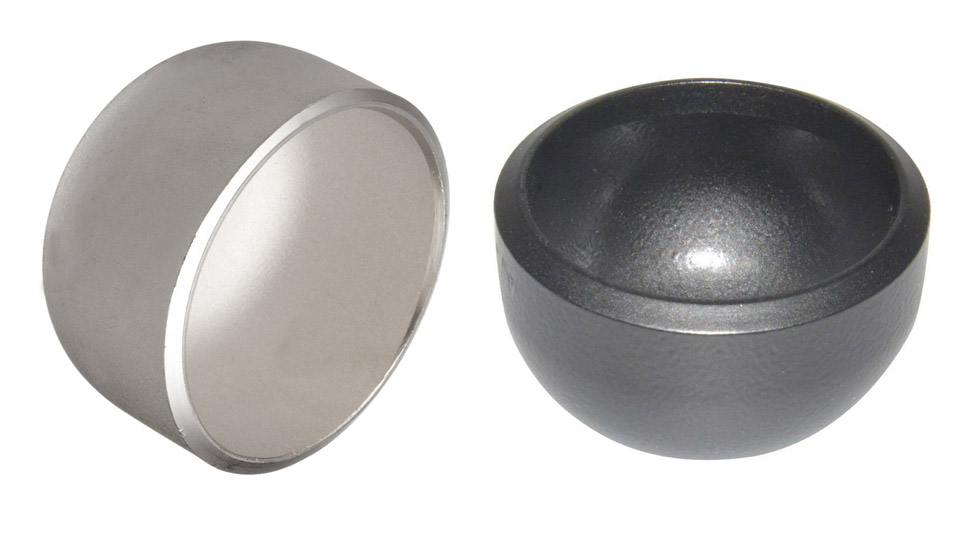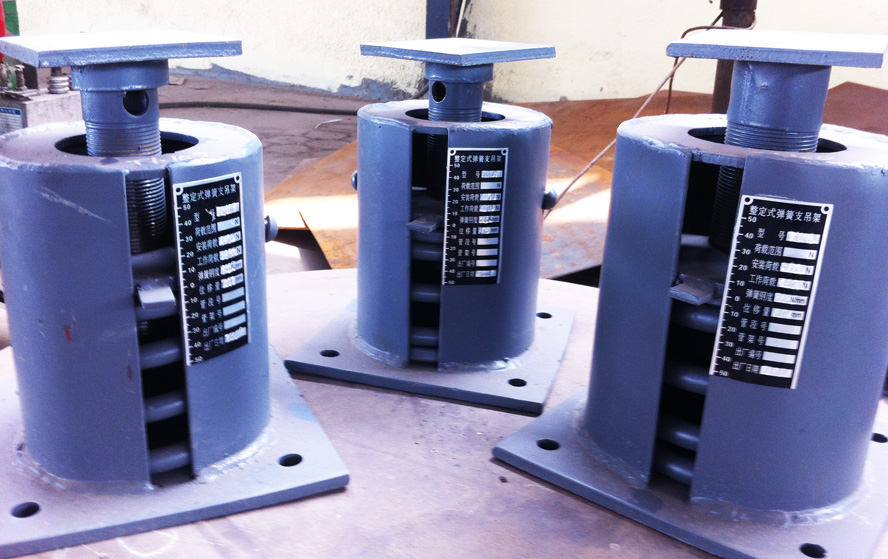Réducteur de tuyau – Concentrique et excentrique
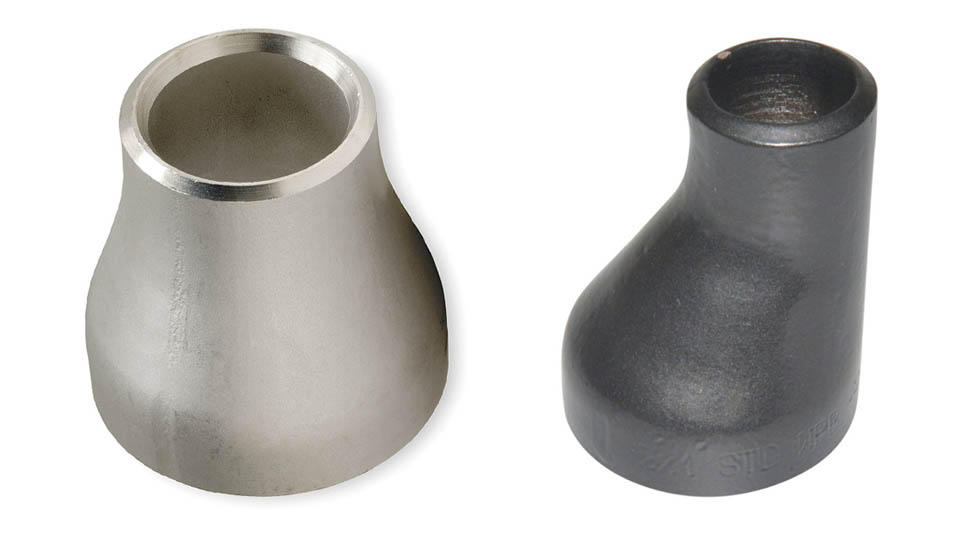
Abter Company propose un large éventail de réducteurs concentriques et excentriques.
Les tolérances dimensionnelles sont conformes à l'ASME B16.9. Les épaisseurs de mur d'ajustement sont conformes à la calendrier standard SCH10,SCH20,SCH30,MST,SCH40,SCH60,SCH80,SCH100,SCH120,SCH160 et ASME B36.19m Pipe de mur.
Les raccords de soudage des boutons sont marqués en permanence par gravure électrochimique conformément à l'ASME B16.9. Les poids d'ajustement estimés sont basés sur une densité de .163 lb / pouce cube.
Un réducteur de tuyau en acier est le composant d'un pipeline qui diminue la taille du tuyau à un alésage plus petit. Il existe deux principaux types de réducteur: réducteur concentrique et excentrique. Certains réducteurs de tuyaux sont fabriqués au moyen de la formation de punch et d'autres en se penchant, extrudage, poussée, moulage ou usinage.
Le réducteur du tuyau en acier est utilisé lorsque l'écoulement liquide augmente ou diminue en petites quantités. Afin d'empêcher la cavitation, Il est également utilisé pour se connecter au trou d'entrée de la pompe. En plus, Il est également utile de connecter les joints dans des instruments comme le débitmètre et la vanne de commande. Le réducteur en acier trouve également des applications dans les usines de sucre et les distilleries, pompes, pétrochimique, industries du ciment et de la construction et des usines d'acier. Il peut être stocké dans des boîtes sans fumigation ou des porte-bois.
Matières premières
* A234 - WPB WP5, WP9, WP11, WP22
* A420 – WPL3 / WPL6
* A403 – WP304/L; Wp316 / l
* A860-wphy 42-46/52-60/65-70
Matériaux spéciaux tels que Monel, Inconel, Avec nous, Duplex SS, etc. sont disponibles sur demande
Spécifications du réducteur de tuyau en acier
| Taper | |||
| Réducteur transparent | Réducteur de soudure | Réducteur de soudage des boutons | |
| Diamètre extérieur | 1/2″ ~ 24″ | 4″ ~ 24″ | 12″ ~ 78″ |
| Épaisseur de paroi | 3 mm ~ 150 mm | ||
| Type de produit | Réducteur concentrique, réducteur excentrique | ||
Norme disponible
Notre entreprise fournit des réducteurs de tuyaux en acier de différentes normes pour répondre aux exigences des clients.
GB/T12459-2005 GB/T13401-2005 GB/T10752-2005
SH/T3408-1996 SH/T3409-1996
SY/T0518-2002 SY/T0510-1998
DL/T695-1999 GD2000 GD87-1101
HG/T21635-1987 HG/T21631-1990
ASME B16.9-2007 ASME B16.25-2007
MSS SP 75-2008
CSA Z245.11-05-2005
EN10253-1-1999 EN10253-2-2007 EN10253-3-2008 EN10253-4-2008
DIN2605-1-1992 DIN2605-2-1995
BS1640-1-1962 BS1640-2-1962 BS1640-3-1968 BS1640-4-1968 BS1965-1-1963
AFNOR NF A 49-289-1990 AFNOR NF A 49-170-1-1999 AFNOR NF A 49-170-2-2009 AFNOR NF A 49-170-3-2009 AFNOR NF A 49-170-4-2009
ISO3419-1981 ISO5251-1981
JIS B2311-2009 JIS B2312-2009 JIS B2313-2009
firmage
| Diamètre nominal | Diamètre extérieur | Fin à la fin | ||
| D1 * d2 | ||||
| DN | NPS | Série A | Séries B | H |
| 20× 15 | 3/4× 1/2 | 26.9× 21,3 | 25× 18 | 38 |
| 20× 10 | 3/4× 3/8 | 26.9× 17,3 | 25×14 | 38 |
| 25×20 | 1×3/4 | 33.7×26.9 | 32×25 | 51 |
| 25× 15 | 1× 1/2 | 33.7× 21,3 | 32× 18 | 51 |
| 32×25 | 1.1/4×1 | 42.4×33.7 | 38×32 | 51 |
| 32×20 | 1.1/4×3/4 | 42.4×26.9 | 38×25 | 51 |
| 32× 15 | 1.1/4× 1/2 | 42.4× 21,3 | 38× 18 | 51 |
| 40×32 | 1.1/2×1.1/4 | 48.3×42.4 | 45×38 | 64 |
| 40×25 | 1.1/2×1 | 48.3×33.7 | 45×32 | 64 |
| 40×20 | 1.1/2×3/4 | 48.3×26.9 | 45×25 | 64 |
| 40× 15 | 1.1/2× 1/2 | 48.3× 21,3 | 45× 18 | 64 |
| 50×40 | 2×1.1/2 | 60.3×48.3 | 57×45 | 76 |
| 50×32 | 2×1.1/4 | 60.3×42.4 | 57×38 | 76 |
| 50×25 | 2×1 | 60.3×33.7 | 57×32 | 76 |
| 50×20 | 2×3/4 | 60.3×26.9 | 57×25 | 76 |
| 65×50 | 2.1/2×2 | 73.0×60.3 | 76×57 | 89 |
| 65×40 | 2.1/2×1.1/2 | 73.0×48.3 | 76×45 | 89 |
| 65×32 | 2.1/2×1.1/4 | 73.0×42.4 | 76×38 | 89 |
| 65×25 | 2.1/2×1 | 73.0×33.7 | 76×32 | 89 |
| 80×65 | 3×2.1/2 | 88.9×73.0 | 89×76 | 89 |
| 80×50 | 3×2 | 88.9×60.3 | 89×57 | 89 |
| 80×40 | 3×1.1/2 | 88.9×48.3 | 89×45 | 89 |
| 80×32 | 3×1.1/4 | 88.9×42.4 | 89×38 | 89 |
| 90×80 | 3.1/2×3 | 101.6×88.9 | – | 102 |
| 90×65 | 3.1/2×2.1/2 | 101.6×73.0 | – | 102 |
| 90×50 | 3.1/2×2 | 101.6×60.3 | – | 102 |
| 90×40 | 3.1/2×1.1/2 | 101.6×48.3 | – | 102 |
| 90×32 | 3.1/2×1.1/4 | 101.6×42.4 | – | 102 |
| 100×90 | 4×3.1/2 | 114.3×101.6 | – | 102 |
| 100×80 | 4×3 | 114.3×88.9 | 108×89 | 102 |
| 100×65 | 4×2.1/2 | 114.3×73.0 | 108×76 | 102 |
| 100×50 | 4×2 | 114.3×60.3 | 108×57 | 102 |
| 100×40 | 4×1.1/2 | 114.3×48.3 | 108×45 | 102 |
| 125×100 | 5×4 | 141.3×114.3 | 133×108 | 127 |
| 125×90 | 5×3.1/2 | 141.3×101.6 | – | 127 |
| 125×80 | 5×3 | 141.3×88.9 | 133×89 | 127 |
| 125×65 | 5×2.1/2 | 141.3×73.0 | 133×76 | 127 |
| 125×50 | 5×2 | 141.3×60.3 | 133×57 | 127 |
| 150×125 | 6×5 | 168.3×141.3 | 159×133 | 140 |
| 150×100 | 6×5 | 168.3×114.3 | 159×108 | 140 |
| 150×90 | 6×3.1/2 | 168.3×101.6 | – | 140 |
| 150×80 | 6×3 | 168.3×88.9 | 159×89 | 140 |
| 150×65 | 6×2.1/2 | 168.3×73.0 | 159×76 | 140 |
| 200×150 | 8×6 | 219.1×168.3 | 219×159 | 152 |
| 200×125 | 8×5 | 219.1×141.3 | 219×133 | 152 |
| 200×100 | 8×4 | 219.1×114.3 | 219×108 | 152 |
| 200×90 | 8×3.1/2 | 219.1×101.6 | – | 152 |
| 250×200 | 10×8 | 273.0×219.1 | 273×219 | 178 |
| 250×150 | 10×6 | 273.0×168.3 | 273×159 | 178 |
| 250×125 | 10×5 | 273.0×141.3 | 273×133 | 178 |
| 250×100 | 10×4 | 273.0×114.3 | 273×108 | 178 |
| 300×250 | 12× 10 | 323.9×273.1 | 325×273 | 203 |
| 300×200 | 12×8 | 323.9×219.1 | 325×219 | 203 |
| 300×150 | 12×6 | 323.9×168.3 | 325×159 | 203 |
| 300×125 | 12×5 | 323.9×141.3 | 325×133 | 203 |
| 350×300 | 14×12 | 355.6×323.9 | 377×325 | 330 |
| 350×250 | 14× 10 | 355.6×273.0 | 377×273 | 330 |
| 350×200 | 14×8 | 355.6×219.1 | 377×219 | 330 |
| 350×150 | 14×6 | 355.6×168.3 | 377×159 | 330 |
| 400×350 | 16×14 | 406.4×355.6 | 426×377 | 356 |
| 400×300 | 16×12 | 406.4×323.9 | 426×325 | 356 |
| 400×250 | 16× 10 | 406.4×273.0 | 426×273 | 356 |
| 400×200 | 16×8 | 406.4×219.1 | 426×219 | 356 |
| 450×400 | 18×16 | 457×406.4 | 478×426 | 381 |
| 450×350 | 18×14 | 457×355.6 | 478×377 | 381 |
| 450×300 | 18×12 | 457×323.9 | 478×325 | 381 |
| 450×250 | 18× 10 | 457×273.0 | 478×273 | 381 |
| 500×450 | 20× 18 | 508×457 | 529×478 | 508 |
| 500×400 | 20×16 | 508×406.4 | 529×426 | 508 |
| 500×350 | 20×14 | 508×355.6 | 529×377 | 508 |
| 500×300 | 20×12 | 508×323.9 | 529×325 | 508 |
| 550×500 | 22×20 | 559×508 | – | 508 |
| 550×450 | 22× 18 | 559×457 | – | 508 |
| 550×400 | 22×16 | 559×406.4 | – | 508 |
| 550×350 | 22×14 | 559×355.6 | – | 508 |
| 600×550 | 24×22 | 610×559 | – | 508 |
| 600×500 | 24×20 | 610×508 | 630×529 | 508 |
| 600×450 | 24× 18 | 610×457 | 630×478 | 508 |
| 600×400 | 24×22 | 610×406.4 | 630×426 | 508 |
| 650×600 | 26×24 | 660×610 | – | 610 |
| 650×550 | 26×22 | 660×559 | – | 610 |
| 650×500 | 26×20 | 660×508 | – | 610 |
| 650×450 | 26× 18 | 660×457 | – | 610 |
| 700×650 | 28×26 | 711×660 | – | 610 |
| 700×600 | 28×24 | 711×610 | 720×630 | 610 |
| 700×550 | 28×22 | 711×559 | – | 610 |
| 700×500 | 28×20 | 711×508 | 720×530 | 610 |
| 750×700 | 30×28 | 762×711 | – | 610 |
| 750×650 | 30×26 | 762×660 | – | 610 |
| 750×600 | 30×24 | 762×610 | – | 610 |
| 750×550 | 30×22 | 762×559 | – | 610 |
| 800×750 | 32×30 | 813×762 | – | 610 |
| 800×700 | 32×28 | 813×711 | 820×720 | 610 |
| 800×650 | 32×26 | 813×660 | – | 610 |
| 800×600 | 32×24 | 813×610 | 820×630 | 610 |
| 850×800 | 34×32 | 864×813 | – | 610 |
| 850×750 | 34×30 | 864×762 | – | 610 |
| 850×700 | 34×28 | 864×711 | – | 610 |
| 850×650 | 34×26 | 864×660 | – | 610 |
| 900×850 | 36×34 | 914×864 | – | 610 |
| 900×800 | 36×32 | 914×813 | 920×820 | 610 |
| 900×750 | 36×30 | 914×762 | – | 610 |
| 900×700 | 36×28 | 914×711 | 920×720 | 610 |
| 950×900 | 38×36 | 965×914 | – | 610 |
| 950×850 | 38×34 | 965×864 | – | 610 |
| 950×800 | 38×32 | 965×813 | – | 610 |
| 950×750 | 38×30 | 965×762 | – | 610 |
| 1000×950 | 40×38 | 1016×965 | – | 610 |
| 1000×900 | 40×36 | 1016×914 | 1020×920 | 610 |
| 1000×850 | 40×34 | 1016×864 | – | 610 |
| 1000×800 | 40×32 | 1016×813 | 1020×820 | 610 |
| 1050×1000 | 42×40 | 1067×1016 | – | 610 |
| 1050×950 | 42×38 | 1067×965 | – | 610 |
| 1050×900 | 42×36 | 1067×914 | – | 610 |
| 1050×850 | 42×34 | 1067×864 | – | 610 |
| 1100×1050 | 44×42 | 1118×1067 | – | 610 |
| 1100×1000 | 44×40 | 1118×1016 | 1120×1020 | 610 |
| 1100×950 | 44×38 | 1118×965 | – | 610 |
| 1100×900 | 44×36 | 1118×914 | 1220×920 | 610 |
| 1150×1100 | 46×44 | 1168×1118 | – | 711 |
| 1150×1050 | 46×42 | 1168×1067 | – | 711 |
| 1150×1000 | 46×40 | 1168×1016 | – | 711 |
| 1150×950 | 46×38 | 1168×965 | – | 711 |
| 1200×1150 | 48×46 | 1220×1168 | – | 711 |
| 1200×1100 | 48×44 | 1220×1118 | 1220×1120 | 711 |
| 1200×1050 | 48×42 | 1220×1067 | – | 711 |
| 1200×1000 | 48×40 | 1220×1016 | 1220×1020 | 711 |
Quelle est la différence entre Réducteur concentrique et Réducteur excentrique ?
Réducteur concentrique
Les extrémités ouvertes d'un réducteur concentrique sont alignées et centrées sur l'autre. En général, Ce type de réducteur de tuyau est utilisé pour modifier la taille de l'alésage du pipeline de deux (maximum trois) mesures, Pour éviter une chute de pression excessive dans le pipeline.
Si une réduction plus importante est nécessaire, alors une séquence de réducteurs doit être utilisée pour avoir un ajustement lisse et progressif de la taille de l'alésage du pipeline (contre. un changement radical).
Pour les réductions de petite alésage, La réduction des brides peut être une alternative aux réducteurs Buttweld.

Réducteur excentriqueLes extrémités ouvertes d'un réducteur excentrique sont dans une position «décalée» à l'autre.
Les réducteurs excentriques sont utilisés, en général, pour les pipelines installés en position horizontale (tandis que les réducteurs concentriques sont utilisés pour les pipelines installés verticalement ou pour les entrées des pompes d'aspiration, comme réducteurs excentriques plats supérieurs).

Processus de fabrication des réducteurs de tuyaux
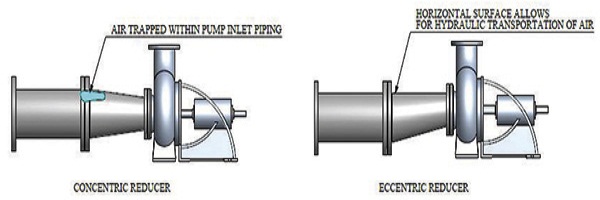
Reducer concentrique vs excentrique
La principale différence entre le réducteur concentrique vs excentrique est l'entrée de l'entrée vs. la sortie de l'ajustement, qui est parfait pour un réducteur concentrique et le décalage d'un réducteur excentrique.
Processus de fabrication de réducteur BW
La formation à froid est le processus de fabrication le plus courant pour les réducteurs excentriques / concentriques transparents (Les réducteurs soudés sont produits avec le processus de soudure de couture simple ou double):
